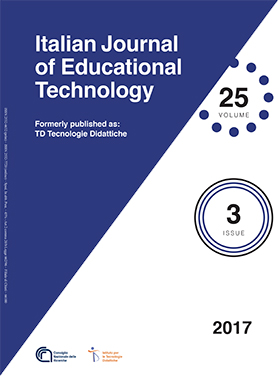Editorial
Main Article Content
Abstract
This issue of the Italian Journal of Educational Technology includes five articles that tackle a range of
different research topics. The first two both examine social networking but from different perspectives. In
“Integrating learning management and social networking systems”, Terry Anderson and Jon Dron analyse
how social networks have become a feature of the distance education landscape in so far as their integration
in learning management systems has proved to offer unprecedented advantages for connecting communication,
entertainment and informal learning in formal education. To illustrate this, the authors provide an
account of how Athabasca University integrated the Elgg platform into their LMS as part of the university’s
distance learning programs.
The second of the two papers dedicated to social networking deals with academic social network sites and
researchers’ professional learning on these sites. In “An analysis of ResearchGate and Academia.edu as
socio-technical systems for scholars’ networked learning: a multilevel framework proposal”, Stefania Manca
analyses these platforms from a networked learning perspective. This involves a three-level framework
conceived for investigating the technological features that ResearchGate and Academia.edu provide for
the purposes of open dissemination of scholarly practice, information sharing, and researchers’ networked
learning.
The third paper, “Fuori orario. Il tempo docente nella didattica online”, by Manuela Milani, Juliana Elisa
Raffaghelli and Patrizia Ghislandi, deals with the issue of teachers’ workload in online learning. The authors
describe an investigation aimed at understanding instructors’ perspectives on online teaching time and the
factors that prevent appropriate acknowledgment of online teaching workload by institutional authorities.
In “L’approccio Flipped Classroom nel Movimento ‘Avanguardie Educative’ ”, Michelle Pieri and Chiara
Laici report the results of an investigation into the adoption of the Flipped Classroom approach in schools.
These show that the approach is mainly adopted in an effort to actively engage students in the learning
process, and that learning-to-learn and digital competence are the two student competences most directly
supported by this approach.
The fifth paper, “Multimodalità e scrittura tradizionale a confronto: un intervento nella scuola secondaria”
reports an experience in which secondary school students were confronted with the concepts of textuality
and multimodality. Paola Cortiana analyses the relationship between traditional writing and the multimodal
approach, and the effects on students in a number of writing experiments.
Article Details
Section
Authors who publish with this journal agree to the following terms:
- Authors retain copyright and grant the journal right of first publication with the work simultaneously licensed under a Creative Commons CC BY 4.0 Attribution 4.0 International License.
- Authors are able to enter into separate, additional contractual arrangements for the non-exclusive distribution of the journal's published version of the work (e.g., post it to an institutional repository or publish it in a book), with an acknowledgement of its initial publication in this journal.
- Authors are permitted and encouraged to post their work online (e.g., in institutional repositories or on their website) prior to and during the submission process, as it can lead to productive exchanges, as well as earlier and greater citation of published work (See The Effect of Open Access)

